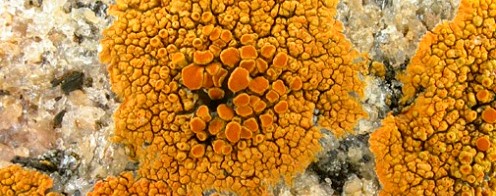Lichen herbarium
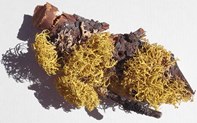
Letharia vulpina or wolf lichen (Danish: Ulvelav). Wolf lichen contains the yellow pigment vulpinic acid. This has historically been used to poison wolves and foxes. The lichen itself is an effective poison, but to enhance the effect, the lichen was dried, mixed with reindeer meat and pieces of glass. This was stuffed in carcasses of reindeer as it was suggested that the sharp edges of the glass would make the animals' internal organs more susceptible to the lichen poison. Has been used traditionally by native ethnic groups to poison arrows, and as treatment for wounds and inflammation. The herbarium holds specimens from North America.
Curator
Collection manager
About the collection
The herbarium holds a collection of c. 280,000 specimens of lichenized fungi from all taxonomical groups and from all over the world. It holds the largest collections of Danish (c. 900 species) and Greenlandic (c. 950 species) lichens, where the coverage is almost complete. In total the collection holds 4,000 of 17,000 described species. The collection holds several types from all around the world. The collection holds the main collections from J.S. Deichmann Branth, M. Skytte Christiansen, O. Galløe, H. Mølholm Hansen, M. Lund, J. Vahl, N. Hartz and E.S. Hansen.
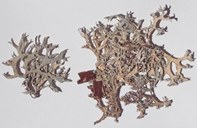
Evernia prunastri or oakmoss (Danish: Almindelig slåenlav). Probably the economically most important lichen. Extracts are used in the perfume industry and may make up 1-12% of the final perfume. Harvested in thousands of tons each year in South and Middle Europe. The herbarium holds specimens from Denmark.
The Danish lichen herbarium is rich in lichens from all parts of Denmark. The oldest collections are almost 200 years old. All Danish lichen collections are digitally available through Svampeatlas. Those collected by J. S. Deichmann Branth and E. Rostrup, the authors to “Lichenes Daniae eller Danmarks Laver” from 1869 are still considered important.
The material of Cladonia collected by H. Mølholm Hansen and M. Lund is of importance, too. In addition, C. F. E. Erichsen, O. Galløe, M. Skytte Christiansen, V. Alstrup, U. Søchting and S. Svane have contributed with a valuable material of Danish lichens. Since 1995 E. S. Hansen assisted by S. N. Christensen and P. Corfixen has edited “Lichenes Danici Exsiccati” consisting of totally 36 fascicles with 845 numbers of lichens from most parts of Denmark.
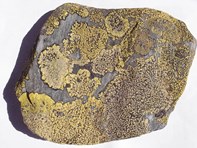
Rhizocarpum geographicum or map lichen (Danish: Gulgrøn landkortlav). R. geographicum and other similar lichens are used in lichenometry because of its slow growth (0. 1 mm/year) and old age (5000 years old or more); e.g. be used for monitoring retreat of glaciers. The herbarium holds specimens from all parts of the world. The depicted thalli are from Norway.
The Greenland lichen herbarium holds the most important lichen collection in the world. J. Vahl, who visited Greenland in the years around 1830, and Th. M. Fries some years later collected material of lichens mainly from West Greenland and N. Hartz at the end of this century from East Greenland. B. Lynge, P. F. Scholander and E. Dahl are the most important contributors in the first half of the nineteenths century. Since then K. Hansen, V. Alstrup, F. J. Daniels, S. Svane, P. Gelting and E. S. Hansen have contributed with numerous collections, in particular the two last mentioned lichenologists with about 100,000 specimens. M. S. Christiansen collected many lichens in West Greenland in 1947, but only a part of this material has been prepared for intercalation in the herbarium. G. Degelius and K. Hansen are important contributors with lichens from the Faroe islands. Since 1972 E. S. Hansen has edited and contributed with a large material to “Lichenes Groenlandici Exsiccati” consisting of 36 fascicles with 1174 numbers of lichens.
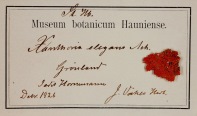
Xanthoria elegans from Jens Vahls collection.
Lichen herbarium in numbers
- Estimated number of specimens/collections: Approx. 280,000
- Types: c. 1,200
- Digitally available specimens: c. 66,000. The Danish lichens (45,000 specimens) are all digitally available.
- Percentage databased: c. 25%
Strengths
- Greenland lichens– almost 100% coverage
- Danish lichens – almost 100% coverage
Important subcollections
The most important subcollections are those by Deichmann Branth, M. Skytte Christiansen, Galløe, Mølholm Hansen, Hartz, Lund, J. Vahl, E.S. Hansen.
The most important exciccates are:
- Lichenes Africani (Almborn, O; Lund)
- Lichenes Canadensis Exsiccati (Brodo, I. M ; Ottawa)
- Lichenes Lusitaniae Selecti Exsiccati (Tavares, C. N)
- Lichenotheca Fennica (Hakulinen, R)
- Lichenes Rariores et Critici Exsiccati (Kurokawa; S. & H. Kashiwadani; Tokyo)
- Lichenes Minus Cogniti Exsiccati (Tokyo)
- Lichenes Exsiccati Norvegiae (Havaas, J. J.; Bergen)
- Lichenes Exsiccati (Nash, T. H; Arizona)
- Lichenes Exsiccati (Verseghy, K)
- Liches Exsiccati (Weber, A. W)
- Fungi Lichenicola Exsiccati (Santesson R; Uppsala)
- Lichenes Selecti Exsiccati Upsalienses (Uppsala)
- Lichenotheca Latinoamericana (Sipman, H; Berlin)
- Lichenes Exsiccati (Boulder)
- Lichenes Exsiccati (Minnesota)
- Lichenotheca Graecensis (??; Graz)
- Lichenotheca Fennica (Räsänen, V)
- Lichenes Isidiosi et Sorediosi Crustacei Exsiccati (Bergen)
- Lecideaceae Exsiccatae (Hertel, H; München)
- Cladoniaceae Americanae Exsiccatae (Hale, M. E.; Farlow Herbarium, Harvard)
- Cladoniae Exsiccatae(Sandstede, H)
- Lichenes Selecti Exsiccati (Moberg, R)
- Lichenes Selecti Exsiccati (Vezda, A)
- Lichenes Alpium et Regionum Confinium (Poelt J. & M. Steiner)
- Caliciales Exsiccatae (Tibell, L)
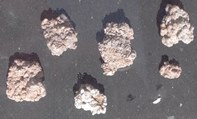
Aspicilia esculenta or manna lichen (Danish: mannalav). A desert lichen of Iran and Northern Africa. It is a likely candidate for the biblical manna mentioned in Exodus in the Bible. It forms hard, round growths, loosely or not at attached to the substrate and is blown around in heavy winds. The lichen is considered edible and people in Asia are known to have eaten it, at least in times of famine. The herbarium holds specimens from Russia.
History
The oldest and most well-preserved lichens in the herbarium is from Jens Vahl (1796-1854)s expedition to East Greenland in 1828.
Several lichenologists have been affiliated with the University, e.g. H. Mølholm Hansen (mainly Cladonia), M. Skytte Christiansen (Danish lichens), V. Alstrup, U. Søchting. Eric Steen Hansen, the first official curator on lichen herbarium (1967-2015), have been collecting lichens on more than 40 expeditions to all part of Greenland, starting in 1969 as well as in Denmark. Eric Steen Hansen is emeritus at the museum and is still actively collecting and publishing.

